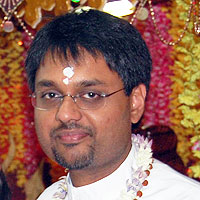From a satsang with Pt. Dr. Umesh Persad, Spiritual Leader, SWAHA Gyaan Deepak Kirtan Mandali
What are the main scriptures of Sanatan Dharma? For a long time, the experiences of the ancient sages were passed on via oral tradition. The Guru would relay the knowledge to the disciple who would then pass it on orally. It was only documented in books when writing was developed.
In Sanaatan Dharma, there are two classes of scriptures: the srutis are that which are heard by the rishis. They are authoritative, such as the Vedas. If we condense the Vedas’ Upanishads, we get the essence of the Bhagavad Gita. It forms the direct experience of the rishis.
The sages also created a second line of wisdom called a smriti. It is that which is remembered. It is based on the power of narrative and storytelling so that it is easily digestible by the human mind. The smritis consist of the Puraanas, such as the Bhagavad Maha Puraan, Devi Puraan, Shiva Puraan and Vishnu Puraan. There are also two main itihaasas, stories, which are more historically based, the Ramaayan and the Mahabhaarat. However, over time, the written documents changed as authors changed.
The Bhagavad Gita states that the self must lift itself up. However, the scriptures also state that the mind is a bundle of thoughts. The root thought that we all have is “I am a person.” Who is the source of that ‘I’? In all of us, Vishnu resides in yoga nidra. That is, we are unaware of our true nature; we are asleep, physically and spiritually.
The main problem is anava-mal; you and I feel that we are incomplete. This is a root dissatisfaction within us. The nature of life is to suffer from that sense of incompleteness. We also are buffeted by the opposing forces of attraction and aversion. We fear that we will not get what we wish for or that we will lose what we have. These give rise to all the other shadaripu or impurities inside. When we get what we want it might lead to further greed, pride or arrogance. When we don’t get what we want, we might suffer from envy or anger. Thus, whether we follow the paths of bhakti, gyaan, karma or raj yoga, the journey always begins on the inside, with the purification of the self.
In order to progress spiritually, we must awaken the sleeping Vishnu within. He then appeals to Mahaa Kaali, the Supreme Spirit and basis of all things. Therefore, as individuals on the spiritual path, we must first become aware that there is something bigger than ourselves. As we proceed through life, we will become tired of the constant tug of war between pleasure and pain. This leads us to ponder the meaning of existence, Mahaa Kaali, the underlying spirituality. On the spiritual path we also experience Devi as mumukshutva, the experience of longing for the divine and the yearning to transcend mundane existence. Then we must take action through sudarshan chakra, the right vision that gathers and focuses the mind. We must contemplate our lives, become aware of the forces of attraction and aversion, pleasure and pain, and begin to proceed along the spiritual path to personal transformation.
Transcend the Forces of Attraction and Aversion



